
I get asked all the time if I accept quilts for long arm quilting with minky fabric for the back. The answer is a resounding YES! Minky makes the most soft and luxurious blankets. I have had very little trouble quilting minky backed quilts. In fact, there is no reason that a quilt could not be backed with minky, and quilted on a long arm, or traditional machine for that matter, especially if the quilt maker keeps a few things in mind. Below are my tips for choosing and working with minky as a quilt back.

- Choose a color of minky that closely matches the top of your quilt or matches the color of thread that will be used for quilting. Because of the length of the nap, it is common for the fiber strands to pull through the stitches to the quilt top. For instance if you have a quilt top that is mostly white and you send a black or red minky back to your quilter, and your quilter uses white thread (which she probably will) you will likely see a little black or red speck at every stitch. A long arm quilter has very little control over this happening, but I have found using a ball point needle is helpful.
- Winline 100% bamboo batting is my top choice for quilts with minky. It has an amazing drape and is much less stiff than the more popular 80/20 cotton/poly blend battings. This means you will not loose the cuddle factor of minky because of a stiff batting. Even with more dense quilting patterns, the bamboo batting tends to cuddle better than other battings and gets softer with every wash. I have quilted a few minky backed quilts without any batting at all. This option works too, but you may have more of an issue with fiber pull through that I mentioned earlier.
- Remember that minky comes in wider widths, usually 60″ and 90″. Use this to your advantage. You will likely need less yardage than you would with a cotton backing. In many cases you may avoid putting a seam in your back at all. If you do need to put a seam in your back, remember that minky has a nap. In fabrics with a pile such as velvet and minky, the fibers lay tilted in one direction. When you sew two pieces of minky together, be sure that the fibers are lined up in the same direction. If the naps are running opposite there will be a noticeable difference in color and sheen.
- Make sure your back is cut square. As always when a quilt is quilted on a long arm, the backing must be square for best results. Because minky is slippery it is often not cut square when you purchase it. To cut square edges, lay your minky out on a large surface such as a dining table or the floor. Match the selvedges and use a ruler with a grid and your cutting mat to cut a 90 degree angle.
- Buy more minky than you think. You will want to be generous with the size of your quilt back. Most quilters require quilt backs to be 4″-6″ bigger on all four sides. With minky this is especially critical because it is both stretchy and slippery and a little trickier to work with
- When choosing a quilt design, first consider an more open or loose design. The more dense the quilting on any quilt, the more stiff it tends to be. Keep your quilt at maximum cuddliness by quilting it a little less than a cotton backed quilt.
- Your minky fabric is going to shed! The loose fibers on the cut edge of minky will become loose and fall off and make a mess. Don’t worry, this only happens on the cut edge and will not continue after the initial shedding. I like to shake my minky yardage outside when I first purchase it to elimate the mess inside later. Your quilter will appreciate it if you do this too!
For those of you wishing to quilt your own minky backed quilts at home here are a few great tutorials to check out:
Quilting with Minky by Cluck Cluck Sew
Quilting with Minky fabric on Craftsy with tips from Angela Walters
Backing Quilts with Minky by s.o.t.a.k handmade



Pingback: Sweet Apple Quilt Block {Free Pattern} – Lovely threads
You are the first person to mention the nap. I am trying to find out, since Cuddle has nap, if the backing needs to be laid a certain way. Should the smooth part be going down from the top? Also, does Minky have to be used on the straight of grain, or can it be used on the crosswise grain? With the extra wide, you could use the crosswise grain, and buy less, but the nap would be going sideways. The extra wide just seems like a time-saver and money-saver if it doesn’t have to be sewn on the straight of grain. I hope you understand what I am saying. I have been spending time watching and reading tutorials about Minky and no one has mentioned that the backing has to be laid a certain way, because of the nap.
Hi Lynn. I’’ not sure if there is a proper way for the nap to run but my best guess agrees with you when you suggest the nap running smoothly from top to bottom. I have quilted hundreds of quilts with minky backs and they have been turned various directions. Hope that helps!
Will the heavier chenille minky fabrics make a toddler quilt too heavy? I’m tryng to decide if I should stick with a basic minky or if I’ll be sorry if I use a more textured thicker minky. Your thoughts please.
I don’t think it is too heavy at all. My kids love minky backed quilts. I don’t always like how quilting looks on the back of the textured ones though.
I’m using minky backing for a baby quilt for the first time, my cotton pieced blocks for the top measure 12 x 12 inches. I am using quilters dream lightest batting between the layers. I plan to stitch in the ditch where the large blocks join (it’s 3 by 3 blocks big), but I’m not sure how much quilting to do within each of the 12 inch blocks, or if any is needed at all? Thanks for any suggestions!
Hi Kathie! I would check with the batting manufacturer and see what they recommend as far as quilt spacing. I would recommend quilting closer than 12×12. I think your quilt will hold together better.